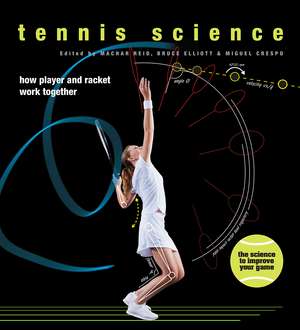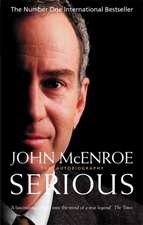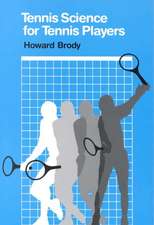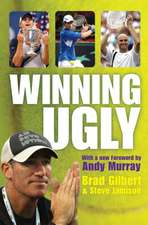Tennis Science: How Player and Racket Work Together
Autor Bruce Elliott, Machar Reid, Miguel Crespoen Limba Engleză Hardback – 26 oct 2015
If you have watched a Grand Slam tennis tournament in the past decade, you are probably aware that the game is dominated by just a few international powerhouses. At the conclusion of each tournament, it is likely that you will see Serena Williams atop the women’s podium and a member of the Big Four—Roger Federer, Rafael Nadal, Novak Djokovic, and Andy Murray—hoisting the trophy for the men. And while there is not a lot of variety in the outcome of these matches, the game of tennis itself has changed drastically over the decades, as developments in technology and conditioning regimens, among other factors, have altered the style of play. Underpinning many of these developments is science, and this book explains the scientific wonders that take the ball from racket to racket and back again.
Each chapter explores a different facet of the game—learning, technique, game analysis, the mental edge, physical development, nutrition for performance and recovery, staying healthy, and equipment—and is organized around a series of questions. How do we learn the ins and outs of hitting the ball in and not out? What are the main technological developments and software programs that can be used to assist in performance and notational analysis in tennis? What role does sports psychology play in developing a tennis player? What is the role of fluid replacement for the recreational, junior, and professional player? What rule changes have been made with respect to the racket, ball, and ball-court interaction to maintain the integrity of the game in the face of technological change? Each question is examined with the aid of explanatory diagrams and illustrations, and the book can be used to search for particular topics, or read straight through for a comprehensive overview of how player and equipment work together.
Whether you prefer the grass courts of Wimbledon, the clay courts of the French Open, or the hard courts of the US and Australian Opens, Tennis Science is a must-have for anyone interested in the science behind a winning game.
Each chapter explores a different facet of the game—learning, technique, game analysis, the mental edge, physical development, nutrition for performance and recovery, staying healthy, and equipment—and is organized around a series of questions. How do we learn the ins and outs of hitting the ball in and not out? What are the main technological developments and software programs that can be used to assist in performance and notational analysis in tennis? What role does sports psychology play in developing a tennis player? What is the role of fluid replacement for the recreational, junior, and professional player? What rule changes have been made with respect to the racket, ball, and ball-court interaction to maintain the integrity of the game in the face of technological change? Each question is examined with the aid of explanatory diagrams and illustrations, and the book can be used to search for particular topics, or read straight through for a comprehensive overview of how player and equipment work together.
Whether you prefer the grass courts of Wimbledon, the clay courts of the French Open, or the hard courts of the US and Australian Opens, Tennis Science is a must-have for anyone interested in the science behind a winning game.
Preț: 283.13 lei
Nou
Puncte Express: 425
Preț estimativ în valută:
54.18€ • 56.36$ • 44.73£
54.18€ • 56.36$ • 44.73£
Carte disponibilă
Livrare economică 25 martie-08 aprilie
Preluare comenzi: 021 569.72.76
Specificații
ISBN-13: 9780226136400
ISBN-10: 022613640X
Pagini: 192
Ilustrații: 150 color plates
Dimensiuni: 229 x 248 x 18 mm
Greutate: 0.93 kg
Editura: University of Chicago Press
Colecția University of Chicago Press
ISBN-10: 022613640X
Pagini: 192
Ilustrații: 150 color plates
Dimensiuni: 229 x 248 x 18 mm
Greutate: 0.93 kg
Editura: University of Chicago Press
Colecția University of Chicago Press
Notă biografică
Bruce Elliott is a senior research fellow in biomechanics in the School of Sport Science, Exercise, and Health at the University of Western Australia. He is the author of numerous articles and books on sports biomechanics. Machar Reid is the sports science and medicine manager for Tennis Australia and coauthor of several books on tennis sports science and coaching. Miguel Crespo is the research officer at the International Tennis Federation (ITF) Development Department, Spain. He runs the ITF’s education program and has coauthored and edited many ITF publications.
Cuprins
Chapter One: Learning the Game
Chapter Two: Technique
Chapter Three: Performance Analysis and Game Intelligence
Chapter Four: The Mental Edge
Chapter Five: Physical Development
Chapter Six: Nutrition and Recovery
Chapter Seven: Staying Healthy
Chapter Eight: Equipment and Technology
Notes
Glossary
Notes on Contributors
Index
Tables of Measurements
Acknowledgments
Chapter Two: Technique
Chapter Three: Performance Analysis and Game Intelligence
Chapter Four: The Mental Edge
Chapter Five: Physical Development
Chapter Six: Nutrition and Recovery
Chapter Seven: Staying Healthy
Chapter Eight: Equipment and Technology
Notes
Glossary
Notes on Contributors
Index
Tables of Measurements
Acknowledgments
Recenzii
“The best tennis book of 2015.”












